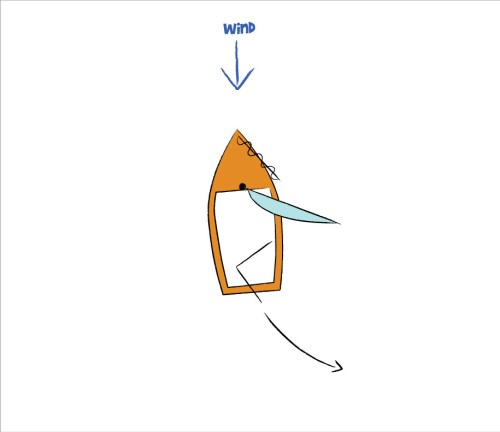Seamanship - Sailing Backwards
Go To: Sailing - Techniques and Manoevres
Posted on 02 November 2009 18:23
The ability to sail backwards may not sound very useful, but it’s a skill that contributes towards boat control and manoeuvrability.
Sailing backwards is a skill that you won’t find useful very often but might just get you out of a tight spot; for example manoeuvring out of a tight spot on a crowded pontoon (it’s unlikely you’d do it in a marina, your boat would probably have an engine), if you find yourself drifting over a start line of a race, or to check your anchor has held when setting anchor. It’s probably the easiest of all the seamanship skills to pick up.
Technique
To sail backwards, you must stop sailing forwards – pretty obvious really, but if you have any forward momentum it will make it more difficult to do. The best setup to start out with is to be sailing along slowly, and then tack, but stop half way through when you are head to wind.
The only way to sail backwards is to push the sail out on the wrong side of the boat, so the wind fills it on the wrong side, pushing you backwards. If you do not get as close to head to wind as possible, you will more than likely fail the attempt – if you stop as you just start to tack, you will not find yourself into the wind enough, and as the wind starts pushing you backwards, it will push you around enough that the wind will then move over the sail just as it does normally when you sail forwards, therefore stopping your sailing backwards progress!
When head to wind, if you have a crew, they should push the boom out towards the wind as much as possible – in strong winds this can require a lot of effort and may require them to stand or at least half-stand with their weight against the boom – this should be done carefully, as a gust could well be enough to knock them off their feet or out of the boat! Nothing need be done with the jib – let it flap, do not jam it off or it could work against you.

Diagram 1: Backwards sailing
While they are doing that (or you if you are in a single handed boat), the helm needs to steer. When sailing backwards, as you might expect, the steering is reversed, just as in a car. In real terms, whichever way you point the tiller, if you follow the direction of the tiller out of the back of the boat, that is the direction in which the boat will travel, as in Diagram A. You should steer very lightly, trying not to overcompensate, as if you oversteer, more than likely the boat will move too far away from head to wind and you will stop sailing backwards – and if you go too far, it is very difficult to recover without starting again from scratch.
As the boat speeds up, you should attempt to move your weight forwards, which should bring the transom out of the water and the stern up – therefore giving less resistance. If you move backwards you will dig the transom in and the water will pile up against it (or over it in an open transom boat causing altogether different problems). Again as the boat speeds up, you may feel the steering attempt to “snatch” or move harder – try to resist it, as you will end up turning the boat too far.
When you have sailed backwards as far as you want, to stop sailing backwards, simply push the tiller further towards the sail, and then the crew (or you) can stop pushing against the sail; the steering will push the boat around out of head to wind, you can pull in the sail and straighten the tiller, and sail away.
Summary
Not a skill that is used often, sailing backwards is easy to pick up, and easy to impress with. When everyone else is waiting for the crowded jetty to empty for them to sail off, if you can sail backwards a few metres, then sail off ahead of everyone else, picking up a few extra brownie points on an instructors course, or getting out to the race course ahead of everyone else for a spot of extra practise and time on the water.